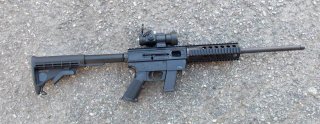An AR-15 in .45 ACP? The Just Right Carbine Gen 3 Rifle
This rifle could be a beast.
When is an AR not an AR? When it’s a JR (Just Right) Carbine Gen 3!
Okay, so you aren’t actually going to mistake a Just Right .45 ACP for an AR-15. But for being a pistol-caliber carbine, AR fans should find the JR Carbine Gen 3 very familiar to use. It features an AR-style trigger, stock, safety, pistol grip, and forends. That way, it's easy to customize your JR Carbine with any number of aftermarket M4/AR-15 parts.
The Just Right’s similarity to an AR-15 is just the beginning of this carbine’s versatility. For a fairly reasonable cost (~$300 or less), you can get a conversion kit to change your .45 ACP to either a 9mm or .40 S&W caliber carbine. That’s like having three different guns, for much less!
Additionally, the JR Carbine is an ambidextrous-style weapon. You can switch the charging handle and ejection direction from one side of the gun to the other. This may be especially nice for southpaws. Something to note is that the magazine release is on the left side of the magazine well, which is not like an AR at all.
The good news is that this carbine uses Glock Model 21 magazines. That means you will be able to buy magazines for your JR .45 ACP just about anywhere—and it won’t be super costly either. You can decide if you want to fire a few rounds, or if you want to switch to a much bigger mag to put thirty or more rounds downrange. The legality of larger magazines depends on your state’s laws and regulations, though.
The JR semi-auto carbine delivers its ammo through a basic blowback system. When the bullet is shot out the barrel, the force of the bullet’s motion pushes the bolt mechanism backwards. The empty cartridge ejects out of the gun, and the magazine pushes up the next bullet. The bolt finishes its path backwards and uses a spring to return to its original position, holding the next bullet in place.
This reloading system works best for handguns and pistol-caliber carbines like the JRC. It amounts to slower semi-auto operation than an AR, but the JR carbine makes up for this with decent accuracy and less recoil.
In this way, the JR carbine combines the easy-to-handle pistol feel with the improved bullet speed and control of a rifle (just like the .338 Lapua rifle). More accurate than most handguns, the JRC .45 ACP can make 1.5-inch groupings for five shots at twenty-five yards. You can thank the threaded 17” barrel for this improvement over pistol accuracy.
The JR .45 ACP weighs about 6.5 pounds, which is none too heavy. Along with its simple bolt mechanism, this semi-auto carbine should be straightforward to use. In terms of trigger pull, the JR .45 breaks fairly cleanly at 7 pounds.
Though not the cheapest pistol-caliber carbine out there, the JR .45 ACP is also a pretty good price. You can find it ranging from the mid-500s to around $800, depending on where you look. Not bad for a semi-auto that’s fun and easy to use, and practical for home defense purposes.
Another nice thing about this carbine is its look. It’s a U.S.-made gun machined from anodized aluminum with a Picatinny top rail machined into the upper receiver. The finishes for these guns vary depending on type and state/regulation model. A black finish is standard, though there is also Kryptek Highlander camo, U.S. Flag, “Muddy Girl” camo, and Nickel options.
If you get the KeyMod Rail model, the rail extends to the free-floating quadrail forend. The Takedown model doesn’t have these rails, but you can twist off the forend without tools for quicker disassembly. Some shooters have actually found that this feature can become an issue. The forend can start loosening while using the gun, though you can fix this using a threadlocking adhesive (like Loctite).
Plenty of rail space on the upper means you can add any optics, stand, lasers, or grip to your gun as you like. This is convenient and fun for customization of your JR .45 ACP. And you probably do want to add at least a sight, since the JRC does not come with any kind of sights or optics included.
There are only two disadvantages that I didn’t like. One is that the bolt doesn’t lock open after your last round (though you can lock it open manually). This may take some getting used to. Some shooters do prefer that their bolt locks open automatically so they can know the mag is empty.
Second, the JRC is harder to disassemble compared to other firearms, including the AR-15. You have to remove the forend and unscrew three Allen screws to take apart the upper from the lower. There are also Phillips head screws to remove the ejection blockoff plate.
A gun that isn't easy to take apart isn't going to be easy to clean. This is unfortunate because the pistol-caliber rounds the JRC uses tend to be messy in the gun. Besides that, the gun is reliable and smooth to shoot.
Which leads us to the big question: should you get a pistol-caliber Just Right Carbine? Well, if you like to shoot AR-15s but want it in .45 ACP form—then get a JRC. It even works for left-handed folks. It’s a ton of fun to shoot, light on recoil, and accurate.
Richard Douglas is a firearms expert and educator. His work has appeared on large publications like The Armory Life, Daily Caller, American Shooting Journal, and more. In his free time, he reviews optics on his Scopes Field blog.
Image: Creative Commons.

